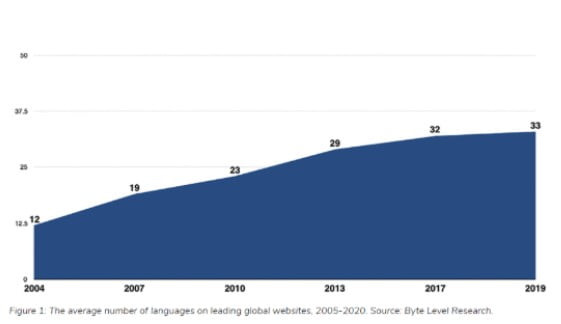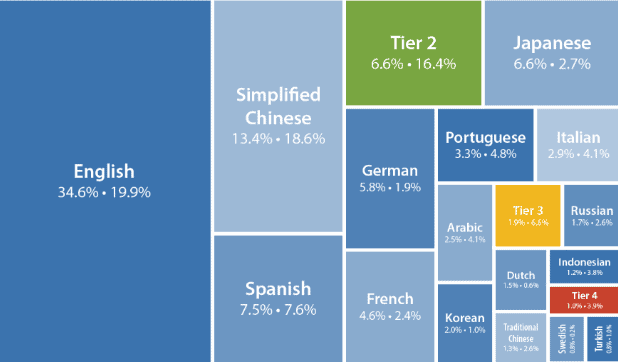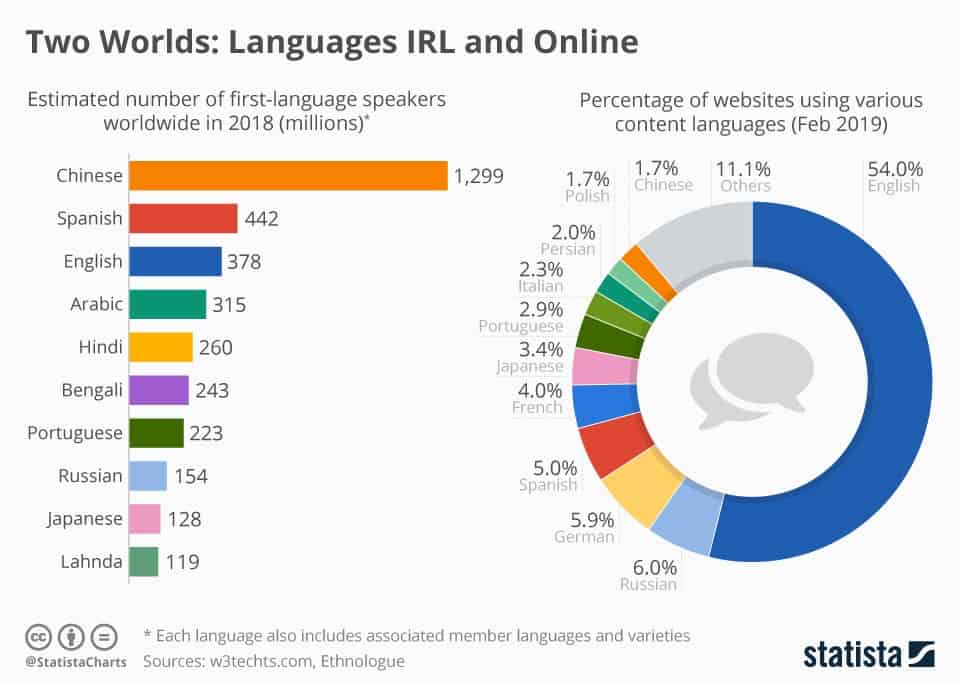|
Listen to Post
|
Listen to this article now:
Among all the changes COVID-19 has brought about, it has also elevated the role of startups as an enabler of digital transformation and a key player in the fight against the virus. A big win we have also achieved amidst this pandemic is to create a global front against the virus where companies form coalitions to support all business sectors and individuals overcome the challenges, remain functional and stay healthy. This has opened new roads for startups which are no more bound by geographical borders. For any software and SaaS products and services, the question of global expansion and international growth comes now much earlier than ever before.
So, while ensuring you can launch an MVP across markets and doing your market research, here’s another aspect you may want to throw in the mix; translation and localization for your target audiences.
Language share in speakers, eGDP and internet penetration
As internet penetration increases, so does the online market share, but the representation of a language in speakers and on the web are two different things.
So, while Chinese and its varieties is the most spoken language worldwide with approximately 1.3 billion native speakers, the dominant language in the web is English with 54% of the top 10 million websites being in English.
An interesting ranking however in the charts above is the one for German, which is nowhere near the top 10 of languages with significant speaker power but ranks third when it comes to its representation on the web.
The reason this is happening is because another consideration in a startup expanding its international footprint is individual buying power, and not all languages have equal per-capita purchase power. As CSA points out in recent survey, German comprises 2% of the online opportunity, but has a per capita amount of approximately US$51,500 while Simplified Chinese comprises 19.4% of global eGDP, but has a relatively low per capita figure (approximately US$9,500).
Language representation on the web
The representation of a language on the web is also affected by its typography and writing system. Software developers probably know that already but for long-tail languages there are many compromises on functionality determined by their enablement and support on the World Wide Web. According to the W3C initiative, there is a respectable number of languages that is under-supported in the web in various areas, from font styles to data formats and text layout.

http://w3c.github.io/typography/gap-analysis/language-matrix.html
As a consideration in a startup’s international growth strategy and depending on their target markets, this poses questions when it comes to their digital offering or even presence.
Different international growth strategies for different offerings
International expansion considerations might differ among startups depending on their digital product. Apps might see faster adoption by targeting different markets compared to a SaaS product or an e-shop solution.
Apps
When it comes to apps, it seems that the Western world comes second, as the largest user base for downloading apps finds itself split among the US, South Korea and Japan, while over 50% of the countries that appear in the top 10 list for downloading apps are non-English speaking ones.
So, if you want to have access to half of the global market, you might want to consider localizing your app in Japanese and Korean.
Websites
In an all-things-digital world, your website is your digital identity. While having one in English might seem like a good idea to begin with, startups targeting foreign markets will also need to boost their market entry with an exceptionally well localized presence.
While the focus is on the product or service, communicating about it cannot be compromised by poor quality messaging or unfamiliar cultural approaches. The “Can’t Read, Won’t Buy” survey conducted as far back as 2014 is even more relevant today. According to this survey,
- 30% of the 3,002 respondents never buy at English-language sites, and another 29% rarely do, and
- across the 10-country sample, 56% either spend more time on sites in their own language than they do in English, or boycott English-language URLs altogether.
These findings are also backed by the increasing average number of languages leading websites support nowadays compared to a few years back.
According to Byte Level Research and the 2020 Web Globalization Report Card, the average number of languages supported on global websites has more than doubled since 2004 reaching 33 languages today.

E-shops
Following suit, e-shops, either as extensions to websites or even when independent, would also need to support their global customers in their local language.
In this case however, the products in question are also a determining factor when deciding how deep you are going to localize. The approach for tech or luxury products might be different for different countries compared to the approach for products in the F&B sector, as consumer sentiment and perception for luxury, technology and food differs substantially among countries and target groups. For example, when it comes to the MESA region, consumers are more tolerant of English copy in ads for luxury and tech products but show a much higher preference in fully localized copy when it comes to personal care products or food.
Below you can see an interesting survey conducted by CSA for B2B buyers in the technology and software sector, which validates that if you are only delivering your website in English, then you risk losing more than half of your potential buyers.

Language prioritization for international reach
As startups work on their international growth strategy, countries might sometimes be deceiving when it comes to the respective localization effort this might entail.
As part of their international growth, startups need not go all in and localize everything in every language – unless of course they are aiming at an aggressive and fast entry and have the necessary funds. However, startups being new in the play field need to be aware of what moving past your national yard and attempting to enter the global field might mean in terms of localization budget. Translation and localization is not a cheap sport, but if handled as a revenue stream and not as a cost center, it pays back in double. Fortunately, a go-global approach can be a step-by-step process. What this might mean for startups is that they can create tiers of languages and content and localize gradually.
So which languages are going to make tier 1 languages for 2022?

Borders and cultural familiarity
According to a survey by The Economist Intelligence Unit two countries which share a common language trade 42% more than two otherwise similar countries which do not have that linguistic connection. What this means for startups is that they could start their expansion strategy by endeavoring in bordering countries and gauging performance, before stretching their feet further in other countries and continents.
However, when taking that leap cultural and language differences must not be taken lightly let alone neglected, as poor translations are considered one of the 4 factors that is most likely to cause the greatest misunderstanding in cross-border communication for organizations at a rate of 23%.
Key points startups need to include in their global expansion considerations
- Show your foreign audiences you value them by speaking their language and speaking it well; this by itself can be a huge differentiator.
- ‘Digital’ might be an all-encompassing term but the translation and localization approaches for digital content are anything but invariable; they can cover pretty much the whole bandwidth of loc services. From transcreation and marketing localization for websites and social media, to SEO-optimized local copy for blog articles, to software localization, to raw machine translated output for user reviews. So, consider partnering with professional agencies who can provide the entire gamut of services and guarantee local teams for the required insight.
- Translation must be seen as a revenue stream, as an investment, and customer experience is a key indicator for that.
- As with every investment, you need to plan and prioritize. Not all content has the same purpose and value, thus not the same share in your localization budget. Prioritize by intent and allocate funds accordingly.









